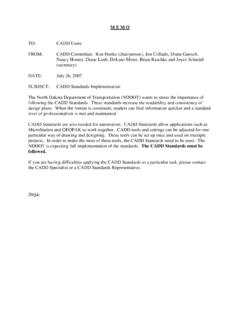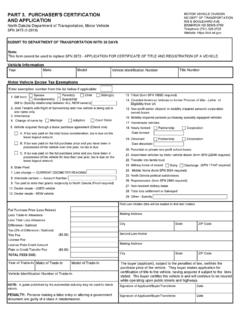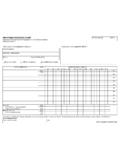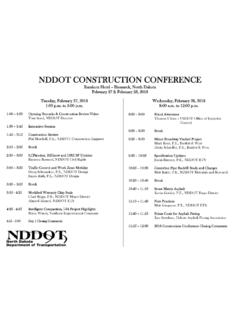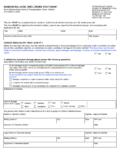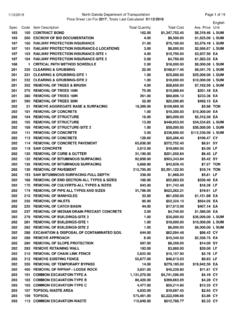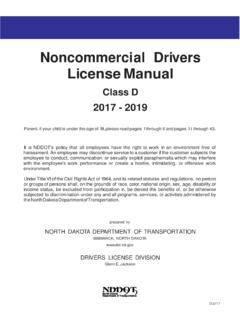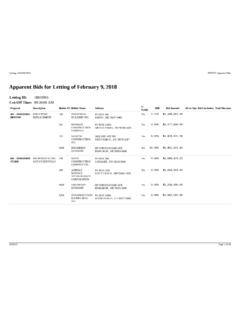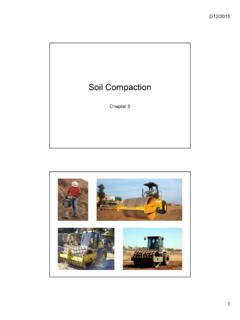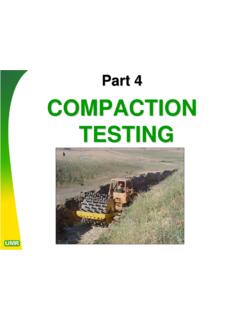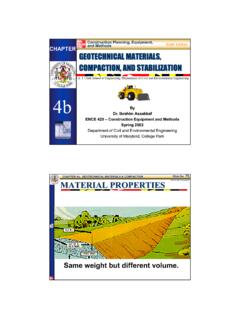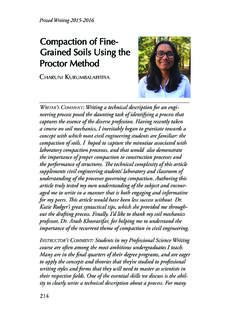Transcription of MOISTURE-DENSITY RELATIONS OF SOILS - DOT Home Page
1 2/13/2015 Revised ND T 99 and ND T 180 _____ ND T 99 and ND T 180 Page 1 of 6 ND T 99 AND ND T 180 MOISTURE-DENSITY RELATIONS OF SOILS Conduct this procedure according to ND T 99 or ND T 180. The NDDOT modifies this standard to only allow the use of Method A and D. Method D shall only be used in lieu of Method A when there is more than 5% by weight of material retained on the No. 4 sieve. Method D shall be used without correction for all soil -aggregates which have all materials passing the 3/4" sieve. Corrections must be made according to ND T 224 for all materials which have 30% or less retained on the 3/4" sieve.
2 If the specified oversized maximum of 30% is exceeded, other methods of compaction control must be used. Consult the current edition of AASHTO for procedure in its entirety and equipment specification details. SCOPE The MOISTURE-DENSITY relationship test is also called the proctor test. This test method determines the relationship between the moisture content and the density of SOILS compacted in a mold. Two different standards of MOISTURE-DENSITY relationships are presently in use by the NDDOT. They vary mainly in the compaction energy applied to the soil in the mold. The two standards and their features are summarized below.
3 METHOD A FEATURE ND T 99 ND T 180 Weight of compaction Rammer lbs 10 lbs Distance of Drop 12" 18" Number of soil Layers 3 5 Diameter of Mold 4" 4" soil Passing Sieve Size No. 4 No. 4 Rammer, Blows/Layer 25 25 2/13/2015 Revised ND T 99 and ND T 180 _____ ND T 99 and ND T 180 Page 2 of 6 METHOD D FEATURE ND T 99 ND T 180 Weight of compaction Rammer lbs 10 lbs Distance of Drop 12" 18" Number of soil Layers 3 5 Diameter of Mold 6" 6" soil Passing Sieve Size 3/4" 3/4" Rammer, Blows/Layer 56 56 REFERENCED DOCUMENTS AASHTO T 99 and T 180 moisture density RELATIONS of SOILS ND T 217 and AASHTO T 217 - Determination of moisture in soil by Means of Calcium Carbide Gas Pressure moisture Tester (Speedy)
4 ND T 265 and AASHTO T 265 - Laboratory Determination of moisture Content of SOILS ND D 2167 and ASTM D 2167 - density and Unit Weight of soil in Place by the Rubber-Balloon Method ND D 4643 and ASTM D 4643 - Determination of moisture Content of soil by Microwave Oven Heating APPARATUS Balance, readable to lbs. (5 g) Oven No. 4 ( mm) sieve Mixing tools moisture sample cans with lids Straightedge, 10" long Knife compaction equipment including density mold, base and collar, and compacting rammer and guide SAMPLE SIZE Method A - A representative soil sample of approximately 35 lbs ( kg) is required for the Multi-Point moisture density Relationship Test, and approximately 7 lbs ( kg) is required for the One-Point moisture density Relationship Test.
5 2/13/2015 Revised ND T 99 and ND T 180 _____ ND T 99 and ND T 180 Page 3 of 6 Method D - A representative soil sample of approximately 125 lbs (55 kg) is required for the Multi-Point moisture density Relationship Test, and approximately 25 lbs (11 kg) is required for the One-Point moisture density Relationship Test. PROCEDURE Multi-Point moisture density Relationship - Mechanical and Manual Record this information on SFN 10063, " moisture density Relationship Test." Calculate and record to the accuracy indicated. If the soil is damp when received, dry until it is easily crumbled under a trowel. It can be air dried or oven dried at a temperature up to 140 F (60 C).
6 Break up the soil chunks so that the entire sample passes through the No. 4 sieve. Avoid reducing the natural size of the particles. Discard any individual particles of material retained on the No. 4 sieve or organic material. Divide the sample into five representative samples of 7 lbs each. Thoroughly mix the first test sample with water to dampen it approximately four percentage points below optimum moisture . A good indication of a soil being right for the first point is if the soil barely forms a cast when squeezed together. Specimen shall be placed in moisture proof container and covered to prevent moisture loss.
7 Mix remaining specimens in the same manner as test sample one, increasing water content by approximately one or two percentage points (not exceeding ) over each preceding specimen. This can be accomplished by adding approximately 60 mL* of water. Allow soil samples to cure in moisture proof containers for a minimum of 12 hours. *If using Method D, the water added to the sample must be increased from approximately 60 mL to approximately 215 mL. Weigh the empty mold without the base plate or collar and record to the nearest lb (5 g). From test sample one: add sufficient material to the mold to produce a compacted layer of approximately 1-3/4" for ND T 99, or 1" for ND T 180.
8 Gently level the soil surface in the mold. *Using a manual compaction rammer or a similar device with a 2" face (50 mm), lightly tamp the soil until it is no longer loose or fluffy. Compact the soil with **25 evenly distributed blows of the compaction rammer. After each layer, trim any soil along the mold walls that has not been compacted with a knife and distribute on top of the layer. *When completing this process using a mechanical compactor, it is recommended to use a spare or extra replacement rammer. 2/13/2015 Revised ND T 99 and ND T 180 _____ ND T 99 and ND T 180 Page 4 of 6 **If using Method D, compact the soil with **56 evenly distributed blows.
9 When using a manual compactor, remember to hold the rammer perpendicular to the base of the mold and lift the rammer to its maximum upward position. Repeat this procedure adding more soil from the same sample each time so that at the end of the last cycle, the top surface of the compacted soil is above the top rim of the mold when the collar is removed. Remove the collar and trim off the extruding soil level with the top of the mold. In removing the collar, rotate it to break the bond between it and the soil before lifting it off the mold. This prevents dislodging chunks of compacted soil when lifting the collar off.
10 The trimming consists of many small scraping motions with a knife or straightedge. After trimming the soil level with the top of the mold, clean all loose material from the outside of the mold. Weigh the soil and mold to the nearest lb (5 g) and record. Subtract the weight of the mold from this weight and divide the result by the volume of the mold. Record results as wet density in pounds per cubic foot (pcf). Compute and record wet density to the nearest pcf. Wet Weight of soil = Weight of Mold + soil Weight of Mold Wet density , pcf = Wet Weight of soil /Volume of Mold Remove the soil from the mold and slice through the center vertically.
